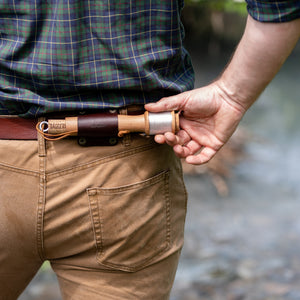How Much Weight Should You Carry When Backpacking?
Whether you’re just starting out or embarking on a seven day journey, backpacking can be a self reflective and unforgettable experience. When it’s just you, your hiking party, and the wilderness around you, the opportunities are endless. With that said, there’s a lot of debate on the definitive rule for how much weight an average hiker should carry. Here’s a deep dive into backpack weight and how to determine what to pack for your trip.
Determining Your Backpack’s Weight
No two hikers are the same, meaning that backpack weight can depend on experience, gear, and the length of your trip. Most hikers follow a general rule of thumb of not carrying more than 20% of their body weight. However, a range between 16-25% of your body weight tends to be comfortable for most hikers, no matter their experience level.
For example, if you currently weigh 150 pounds and your pack adds 30 more to your trip, that’s a total of 180 pounds. This is considered to be a perfect amount of weight for a backpacking trip, but this can change. For instance, this weight may be too heavy for petite hikers, resulting in a need to decrease their pack’s weight to 15%.
Trip Details to Consider
It’s important to analyze your gear and find out what you need for your backpacking trip. How long will you be gone? What are your hiking goals? Where are you going? Even the littlest details may mean the difference between a heavier load and a lightweight pack. Make sure to prioritize items that are absolutely necessary and separate gear that can be overlooked.
Generally speaking, the more time you spend on your trip, the more gear you’ll need. Colder climates will require heavier clothing and advanced hikers may be more focused on intense trekking. You may prefer to relax and enjoy nature from the comforts of your camping site, but this will result in a heavier load.
How Much Should a Backpacking Tent Weigh?
The average hiker should carry a backpacking tent that weighs between 2-3 pounds. However, like the majority of backpacking, this depends on the person. Location, party size, and personal preferences can all contribute to your selected backpacking tent. A solo trip won’t require a four person tent, but a larger hiking party may benefit from a bigger shelter that one person carries.
For colder, harsher climates, invest in a 4 person tent. 3 person tents are well rounded for spring, summer, or fall backpacking trips. Solo travelers and small hiking parties should rely on 1-2 person tents. Single wall tents are waterproof and lightweight, whereas double-wall tents are better for warmer climates.
What is Ultralight Packing?
Ultralight packing refers to hikers who invest in extremely lightweight backpacking gear that reduces their added weight to 15% or less. While it is achievable, it’s not recommended for beginners or people interested in a convenient camping site. Ultralight packing is a difficult but impressive accomplishment for those who choose to attempt the challenge.
Reducing Your Backpack’s Weight
Remove Extra Clothes
It can feel very tempting to bring a lot of clothes, but you can realistically wear the same clothing several days in a row. This can be different for a traditional camping trip, but clothes can weigh a lot, especially in colder climates. It’s better to prioritize apparel designed for prolonged backpacking trips rather than packing several days worth of clothing. Try to stick with moisture repellant, lightweight, and durable clothing when packing for your trip.
Weigh Everything
As a basic rule, If you haven’t weighed something, do it anyway. This includes everything from a small granola bar to your heavier backpacking gear. Use a luggage or kitchen scale to weigh all of your items and determine what you may need to leave out or give to someone else. Consider using organizational resources like spreadsheets or journals to keep track of all your items and how much they’ll weigh for each party member.
Focus on Insulation
When choosing a sleeping bag, focus on insulation rather than size. It’s easy to correlate the two together, but they don’t mean the same thing. It’s possible to invest in a lightweight sleeping bag with better insulation by analyzing its R-value. The higher the R-value of a sleeping bag, the more insulated it will be.
Know How to Pack Your Backpack
It’s one thing to know how much your backpack weighs, but it’s another skill to know how to place those items in your pack. Generally speaking, bulkier objects that take up a lot of space should be reserved for the bottom of your pack (i.e. sleeping bags, tents, and hammocks). Heavier but necessary items should be placed on the top so they’re easy to reach (i.e. snacks, water, and food).
When in Doubt, Start With a Heavier Weight
Although it sounds counterintuitive, beginners should start out with heavier loads and transition to lightweight packs as they gain more experience. This is because heavier packs usually contain all the items you need for an enjoyable backpacking experience. Lightweight packers are usually more focused on intense hiking, carrying only the essentials. Plus, lightweight gear can be very expensive, so it’s best to start out between an average added weight of 20-25 pounds



















